Hinagdanan Cave is a cave found in Panglao Island which is part of the Government Jurisdiction of Bohol in the Philippines. It is lighted naturally by the Sun through a couple of openings in one location and the entrance. It has a lagoon about 10-12 meters deep and it is now used by locals and foreigners as swimming pool because of its natural fresh waters that gradually flow inside and out of the cave. On high tides the taste of the swimming pool is salty due to the rise in sea level which tends to combine with the natural waters of the cave. Sometimes the lake has various pollutants due to ground runoff but because of the regular flow, pollutants remained only in the bottom part of the water. There has been very less reports of accidents that happened in the place.
Hinagdanan Cave is one of the many caves found in the Philippines. Other famous caves I know which can be found in the Philippines are Crystal Cave in Crystal Cove Island, Camotes Cave which is a part of Cebu Province, Hindang Cave in Iligan, Initao Cave in Misamis Oriental among many others. This is also one of Bohol’s tourist attraction. Other famous attractions are Chocolate Hills, Floating Restaurant at Loboc River and Baclayon Church.
The entrance of Hinagdanan Cave has been developed due to a large number of tourists visiting the place. Only one person is allowed at a time when going down to the cave. The narrow concrete stairs is very hard to step into. It was compromised due to the narrow and steep entrance. The handle used to be woods but it is now changed into steel bars to avoid any accidents. The stairs are slippery because of the natural water droplets of Hinagdanan Cave as well as the wet swimmers going in and out.
Inside Hinagdanan Cave are a number of stalactites which can be seen at the ceiling and stalagmites which protrudes on the cave’s grounds. There used to be a lot of bats staying inside the cave, but now you can barely hear these bats squeaking. These bats are hard to see as they hide in the dark areas of the caves.
Hinagdanan Cave is located in the barrio of Bingag in Dauis, Panglao Island, Bohol in the Philippines. It is about 15 kilometers away from the main and lone city of Bohol, Tagbilaran.
Historian says that Bingag used to be covered with a very thick botany. In around 16th century, when people started to settle in the area, they removed most of the planted portions so they can place their homes. When one of the land owners cleared an area with old trunks of trees, he discovered two holes next to each other. He was curious what’s below the holes so he threw some objects down the hole and discovered a splash of water. He continued to explore the bottom area and found a cave with beautiful rock formation and a lagoon with clear fresh water. The limestone and the natural beauty of Hinagdanan Cave made the owner spread the news to the public and started the development of the place. It became a bathing area for locals. They get their water supply from the cave to be used for washing their clothes.
A small ladder or “hagdan” in Filipino was used to go down the cave to avoid slipping through the rocks. Thus the name “Hinagdanan Cave” was made. Food, Drinks, Soap and Shampoo are not allowed to be brought inside the cave. Smoking is definitely not allowed too.
Due to a large number of visitors who are curious to see Hinagdanan Cave, local folks are selling Souvenir Items in the area. Items such as shirts, delicacies, bags, fruit shakes can be bought. There are also a couple of small restaurants so tourists can buy and take their lunch there.
How a Cave is made
Millions of years ago, fallen drops of rain picked up the carbon dioxide (CO2) from the air and from the soil. Carbon dioxide changed the rain water into carbonic acid (an acid found in bubbles of ginger ale and soda). When it fell into limestone, which is a fairly soft rock, it nibbled away the rocks until hair-thin cracks appeared. More rain fell, enlarging the cracks which found new paths between the layers of stones. The paths widened into tunnels. The tunnels crisscrossed and grew into rooms. As long as water filled the tunnel and flowed through the rock-wall room, it grew bigger and bigger. When nothing stops the acid rain water, it can devour vast areas of limestone.
How Hinagdanan Cave could have been formed
Perhaps in the case of Hinagdanan Cave, the work of acid rain was brought to a halt when the rain water joined with an undergoing spring with the sea as an outlet.
How a stalactite is formed
A stalactite is an icicle of stones on the ceiling
- A simple drop of rain clings to the ceiling
- As the water dripped, a tiny ring of lime crystallized in the ceiling.
- A 2nd, a 3rd, a 4th and so on left lime in the same place.
- As time passed, the rings of lime formed a little stone “icicle”. It kept on growing.
How a stalagmite is formed
A stalagmite is the stubby candle on the floor.
- Another drop of rain fell on the floor of the cave.
- As time passed, thousands of drops fell on the same spot. The specks of lime formed what looked like a stubby stone candle.
- The “candle” kept on growing.
How a column is formed
When a stalactite and a stalagmite meet they form a column. Each stalactite and stalagmite grows at a different rate depending on the wetness of a cave, the temperature of the room and the thickness of the limestone above it. Some stalactites and stalagmites grow an inch a year. Others take a hundred of years to grow that much.
- Banner by Island Souvenirs
- Entrance Gate of Hinagdanan Cave
- Stairways going to the cave
- The cave lighted with Bulbs
- The lagoon and stalactites
- Stalactites
- Columns and Stalagmites
- The concrete stairs and steel bars
- The two holes and visitors who are swimming
This page is last updated on
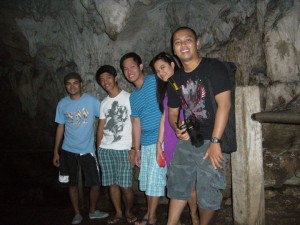

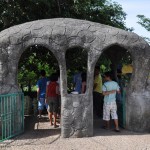
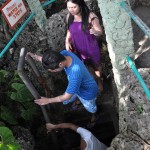
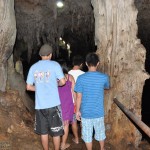
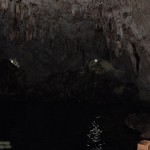
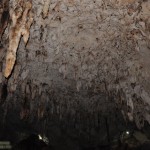
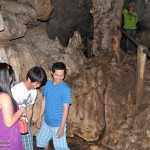
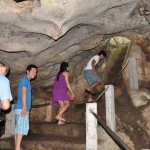
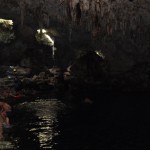
 Mark Anthony Maranga is an Educator-Parent to his 3 Homeschooling Kids. He sells
Mark Anthony Maranga is an Educator-Parent to his 3 Homeschooling Kids. He sells 









